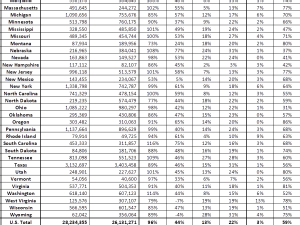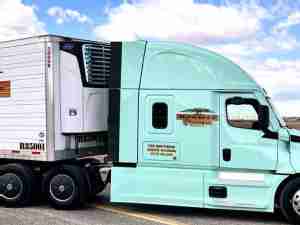Richard Metzler ordered automation equipment as part of a plan to double the volume his small parcel delivery company could handle this holiday season. There’s just one snag: The machinery is stuck on a ship offshore amid a global supply-chain crunch.
“The timing just couldn’t be worse,” said Metzler, chief executive officer of regional courier Lone Star Overnight, who is racing to meet demand from clients such as Best Buy Co. and Nordstrom Inc. in the seven states where LSO delivers. “We’re just having to throw more bodies at it.”
Retailers have increasingly turned to regional couriers like LSO to help shuffle packages that delivery titans United Parcel Service Inc., FedEx Corp. can’t—or won’t. This holiday season is going to depend more than ever on operators taking on business the two dominant couriers are shunning in a rapidly growing delivery market. It’s unclear if the smaller players are ready as they grapple with everything from transportation logjams to worker shortages.
UPS and FedEx have opted to raise prices aggressively and turn away lower-yielding business rather than rush to build capacity. That has been a shock to shippers that rely on those two companies which, along with the U.S. Postal Service, control about 95% of last-mile deliveries of third-party parcels.
Carol Tome, who took over as chief executive of UPS last year, said her company expects to boost revenue per package in part by throttling the volume flowing into its network. “So for some shippers, we’re no longer delivering their packages and that’s OK with us,” Tome said during an Oct. 26 conference call.
FedEx says it expects a 10% jump from last year in the volume of shipments this holiday season to record levels. That translates to 100 million more packages in its network compared with the pre-pandemic 2019 peak period.
Smaller operators such as LSO have tried to boost capacity to handle the pandemic-era flood of e-commerce packages, but it may not be enough to fill the gap before Dec. 25—especially if hiring challenges worsen. Some shoppers might end up with gifts stuck in transit, a worry that could nudge them toward digital gift cards or to pick up online purchases themselves at retail outlets.

Deliveries also will cost more, whether they arrive on time or not. Shippers must contend with double-digit increases for parcel service, including special surcharges, even after they endured price jumps of almost 10% last year, said Josh Dunham, a co-founder of Reveel, a shipping consulting firm. That only adds to rising expenses from supply-chain delays and the trucker shortage.
“If you’re a large shipper and your volume increases a certain percent for peak season, you’re just going to get hammered in fees,” Dunham said. “Most retailers are going to absorb some of the expense and pass on the additional cost” to consumers.
Amid the capacity constraints, both UPS and FedEx have said they’re focusing on small businesses who often pay full price for delivery while applying surcharges on large-volume customers that negotiate discounts. Last year, UPS and FedEx had to limit intake of some packages at times during the holiday season to keep their networks from being overwhelmed, spurring reports of trailer loads of boxes left to sit awaiting pickup.
Amazon.com Inc. is quickly building its network of gray and blue delivery vans but can only handle about three-quarters of its own packages. It relies mostly on UPS and the Postal Service to make up the shortfall. That has inspired Walmart Inc., Target Corp. and other retailers to add their own delivery services. But those efforts aren’t anywhere near the size of Amazon’s network, which now delivers more packages in the U.S. than FedEx, said Satish Jindel, founder of ShipMatrix, a parcel delivery data provider.
“Those are very small right now,” Jindel said of the effort by retailers outside of Amazon to deliver their own packages. “They could grow, but at the moment they don’t scratch the surface.”
The Postal Service, which delivers the most packages of any courier, also said it’s adding machinery before December that will allow it to process 4.5 million more packages a day for this peak season, helping ease the capacity crunch.
The dearth of delivery capacity during this peak season will be less than originally estimated as the supply-chain crunch keeps out merchandise that would have shipped, Jindel said. Also, it helps that more workers are now returning to their offices. A delivery driver then can drop off several business packages to one office location instead of making individual deliveries to several homes, Jindel said, freeing up capacity.
ShipMatrix now forecasts that package volume will outstrip delivery capacity by 1 million packages a day, down from its earlier estimate of 4.7 million, Jindel said.
Gig Startups
Before the pandemic hit, regional couriers like LSO didn’t get much attention from large retailers. But starting last year, those consumer-focused companies were desperate for capacity at any cost and turned to regionals for help. This holiday season, retailers began planning and coordinating early and most regional couriers added capacity. There was even some consolidation that may boost efficiency, with closely held LaserShip Inc.—which operates in the eastern U.S.—purchasing West Coast-focused OnTrac in October.
A number of gig-based delivery startups, including AxleHire and Veho Tech Inc., have been expanding to more cities and even Uber Technologies Inc., Lyft Inc. and other ride-sharing and food-delivery companies have expanded to handle packages.
Regionals and startups offer a safety valve for shippers, but it’s little threat to UPS and FedEx. UPS gobbled up Roadie, the largest of the same-day delivery startups in a deal completed in October. That resulted in one fewer alternative shipper for retailers that turned to Roadie last year, including Tractor Supply Co. and Home Depot Inc.
For all the couriers—big and small—the wild card for keeping up with the deluge of packages will be lack of growth in the labor force, said LSO’s Metzler. FedEx said in September its capacity was constrained because the courier couldn’t hire enough workers for its sorting hubs. Metzler had to increase wages for his sorters by 14% to retain them and hire new ones, he said.
“We’ve got the technology part right, we got the processes, but you need humans to sort and deliver packages,” Metzler said. “So, it’s about finding and winning over the hearts and minds of those sorters and drivers.”











